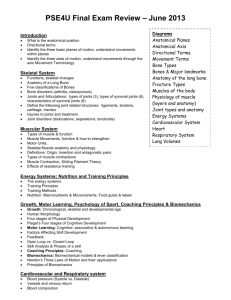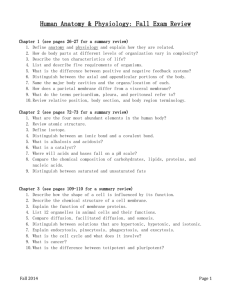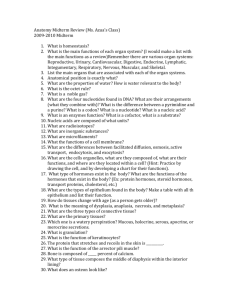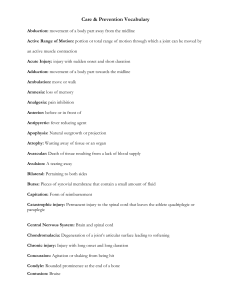BIOL 2401 EXAM REVIEWS 1 Anatomy is/Physiology is
advertisement
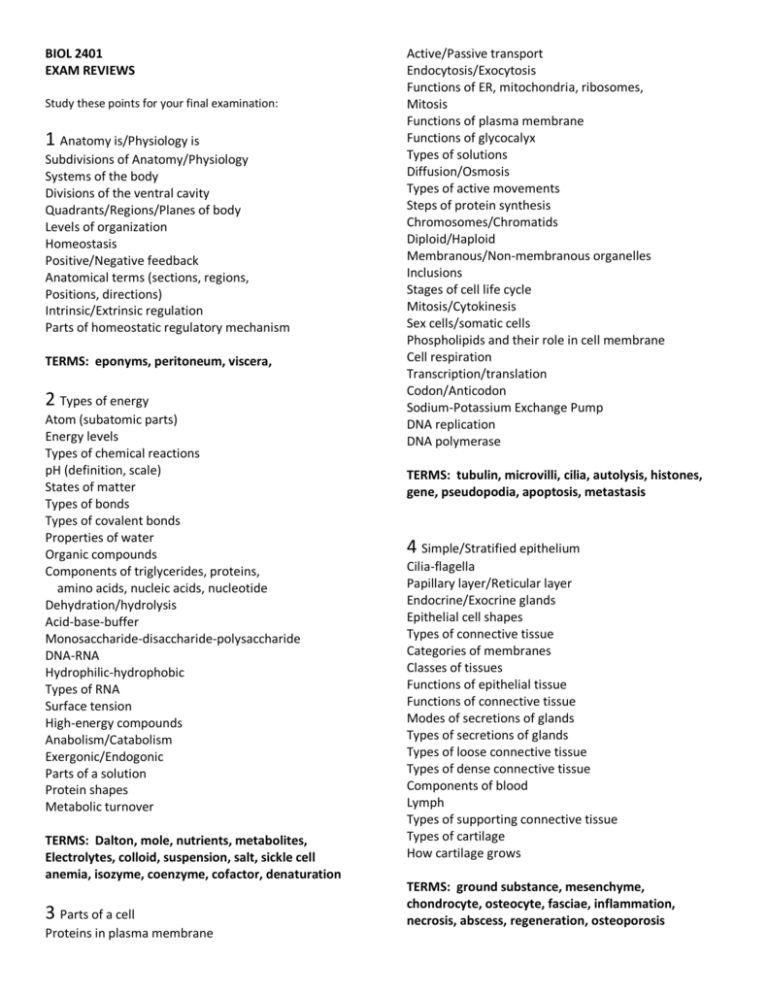
BIOL 2401 EXAM REVIEWS Study these points for your final examination: 1 Anatomy is/Physiology is Subdivisions of Anatomy/Physiology Systems of the body Divisions of the ventral cavity Quadrants/Regions/Planes of body Levels of organization Homeostasis Positive/Negative feedback Anatomical terms (sections, regions, Positions, directions) Intrinsic/Extrinsic regulation Parts of homeostatic regulatory mechanism TERMS: eponyms, peritoneum, viscera, 2 Types of energy Atom (subatomic parts) Energy levels Types of chemical reactions pH (definition, scale) States of matter Types of bonds Types of covalent bonds Properties of water Organic compounds Components of triglycerides, proteins, amino acids, nucleic acids, nucleotide Dehydration/hydrolysis Acid-base-buffer Monosaccharide-disaccharide-polysaccharide DNA-RNA Hydrophilic-hydrophobic Types of RNA Surface tension High-energy compounds Anabolism/Catabolism Exergonic/Endogonic Parts of a solution Protein shapes Metabolic turnover TERMS: Dalton, mole, nutrients, metabolites, Electrolytes, colloid, suspension, salt, sickle cell anemia, isozyme, coenzyme, cofactor, denaturation 3 Parts of a cell Proteins in plasma membrane Active/Passive transport Endocytosis/Exocytosis Functions of ER, mitochondria, ribosomes, Mitosis Functions of plasma membrane Functions of glycocalyx Types of solutions Diffusion/Osmosis Types of active movements Steps of protein synthesis Chromosomes/Chromatids Diploid/Haploid Membranous/Non-membranous organelles Inclusions Stages of cell life cycle Mitosis/Cytokinesis Sex cells/somatic cells Phospholipids and their role in cell membrane Cell respiration Transcription/translation Codon/Anticodon Sodium-Potassium Exchange Pump DNA replication DNA polymerase TERMS: tubulin, microvilli, cilia, autolysis, histones, gene, pseudopodia, apoptosis, metastasis 4 Simple/Stratified epithelium Cilia-flagella Papillary layer/Reticular layer Endocrine/Exocrine glands Epithelial cell shapes Types of connective tissue Categories of membranes Classes of tissues Functions of epithelial tissue Functions of connective tissue Modes of secretions of glands Types of secretions of glands Types of loose connective tissue Types of dense connective tissue Components of blood Lymph Types of supporting connective tissue Types of cartilage How cartilage grows TERMS: ground substance, mesenchyme, chondrocyte, osteocyte, fasciae, inflammation, necrosis, abscess, regeneration, osteoporosis 5 Epidermis/Dermis Melanin/Carotene Ground substance/Fibers Papillary layer/Reticular layer Meissner’s Corpuscles/Pacinian Corpuscle corpuscles Functions of Integumentary System Appendages of the skin Melanocytes Sunlight and Vitamin D3 production Hypodermis role Accessories of the skin Glands found in the skin Secretions of sweat and oil glands Repair of injury in the skin Differences in thick/thin skin Sensible/Insensible perspiration Role of Arrector Pilli muscle Types of hairs Keloids Rickets TERMS: keratinocytes, basal cells, cholecalciferol, calcitriol 6 Functions of skeletal system Bone shapes and bone markings Anatomy of a bone (diaphysis, epiphysis, metaphysis) Types of bone cells Compact bone/Spongy bone Periosteum/Endosteum Ossification/Calcification Types of ossification Appositional growth Effects of exercise, hormones, nutrition of bone Hormones that affect bones Osteopenia/Osteoporosis Ways in which bone differs from cartilage Vitamins involved in bone Yellow bone marrow and red bone marrow Canals: Volkman’s/Haversian TERMS: hydroxyapatite, caniculli, trabeculae, fracture, hematoma, epiphyseal cartilage osteon 7 Bones of the axial skeleton Cranial bones Sinuses, orbital complexes, and nasal complex Fontanelles Sutures Spinal cures and related disorders Vertebral regions Atlas/Axis The ribs The sternum True/False/Floating ribs Hyoid functions TERMS: facets, foramina, TMJ syndrome, dens, Vertebra prominens, ligamentum nuchae, ossicles 8Bones of the appendicular skeleton Pectoral girdle/Pelvic girdle Anatomical differences in the male/female pelvis TERMS: laminae, pollex, hallux, pubic symphysis 9 Structural classes of articulations Functional classes of articulations Categories of joints Types of immovable joints Types of slightly movable joints Synovial joints Accessory structrures Types of movements at synovial joints Types of synovial joints Angular movements/Special movements Intervetebral discs and ligaments TERMS: bursae, articulation, meniscus, herniated disc 10 Types of muscles Perimysium/Epimysium/Endomysium Sarcoplasmic Reticulum Sarcomere Divisions of the A band I band Thick/Thin filaments Levels of functional organization in a skeletal muscle Sliding filament theory Neuromuscular junction Twitch/treppe/wave summation/incomplete and complete tetanus Isometric/Isotonic Contractions Aerobic metabolism Glycolysis Muscle fatigue Stages of muscle metabolism Types of skeletal muscle fibers Intercalated discs Structural characteristics of skeletal, smooth, and cardiac muscle Functional characteristics of cardiac/smooth muscle Role of calcium in muscle contraction Tendons or aponeuroses ATP/CP Adductors-abductors Flexors-extensors Hypertrophy-atrophy Levators-depressors Periods of muscle contraction Function of tropomyosin/troponin TERMS: sarcolemma, cross-bridges, belly, motor unit, acetylcholine, action potential, depolarization, acetylcholinesterase, botulism, flaccid, motor end plate, glycogen 11 Fascicle arrangements Classes of levers Origins and insertions Actions of muscles (antagonist, synergist, agonist) Naming of muscles Axial muscle characteristics Appendicular muscle characteristics Rotator cuff muscles Quadriceps TERMS: fibrosis, hernia, ischemia, Tendon of Achilles, Fulcrum, lever 12 Functional units of nervous system CAN/SNS/ANS/PNS Receptors/Effectors Parts of a neuron Synapse role in transmission Types of synapses Classes of neurons Sensory neurons and motor neurons Interneurons Types of neuroglia cells The blood brain barrier Depolarization, repolarization and hyperpolarization All-or-None Principle Action potential Types of Axons Types of neurotransmitters Sodium-Potassium Pump Saltatory conduction Afferent-Efferent Dendrite-Axon Exteroceptors-Interoceptors-Proprioceptors Presynaptic neuron/Postsynaptic neuron TERMS: myelin sheath, refractory period, summation 13 Meninges White matter/gray matter Horns/columns Perineurium/Epineurium/Endoneurium Spinal nerve/Peripheral nerve Nerve Plexuses Neuronal pools Reflex arc Classes of reflexes Monosynaptic reflexes/polysynaptic reflexes Patellar reflex-Babinski reflex Epidural space and subdural space Tough mother and soft mother Pneumotaxic area and apneustic area TERMS: denticulate ligaments, meningitis, shingles, spinal tap, gray commissures 14 Brain regions Embryology of the brain Ventricles of the brain Protections of the brain CSF (formation, circulation) The Blood-Brain Barrier Functions of the medulla oblongata Functions of the pons Functions of the cerebellum Functions of the mesencephalon, diencephalon Functions of the thalamus and hypothalamus The Limbic System Functions of the cerebrum Integrative centers Classes of brain waves Cranial Nerves TERMS: EEG, hydrocephalus, cerebral cortex, fissure, reticular formation 15 The special senses Adaptation Receptors (nociceptors, thermoreceptors, mechanoreceptors) Types of tactile receptors Somatic sensory pathway Visceral sensory pathway Control of the skeletal muscles Slow pain, fast pain, referred pain The suprarenal glands and the hormones The pineal gland The Pancreatic Islets and the hormones Hormones of other organs and systems Hormones that produce coordinated physiological responses Role of hormones in growth and responses to stress TERMS: anesthesia, cerebral palsy TERMS: Addison disease, cretinism, goiter, hyperglycemia, messenger, calcitonin, 16 ANS Divisions of the ANS Stimulation of sympathetic neurons Stimulation of parasympathetic neurons Neurotransmitters Dual innervations Types of visceral reflexes Types of memory Stages of sleep TERMS: NREM, REM, arousal, RAS, Alzheimer disease 17 The special senses The taste receptors Primary taste sensations Accessory structures of the eye The layers of the eye The retina The chambers of the eye Types of accommodation Accommodation problems Visual pathway External, middle, inner ear The ossicles (malleus, incus, stapes) Equilibrium in the ear The equilibrium pathways The hearing pathway TERMS: umami, glaucoma, conjunctivitis, blind spot, cerumen, frequency, hertz, pitch, decibels Classes of hormones Mechanisms of hormone actions Feedback control of endocrine secretion Hormones of the pituitary gland The functions of the thyroid hormones The parathyroid gland and its hormones


